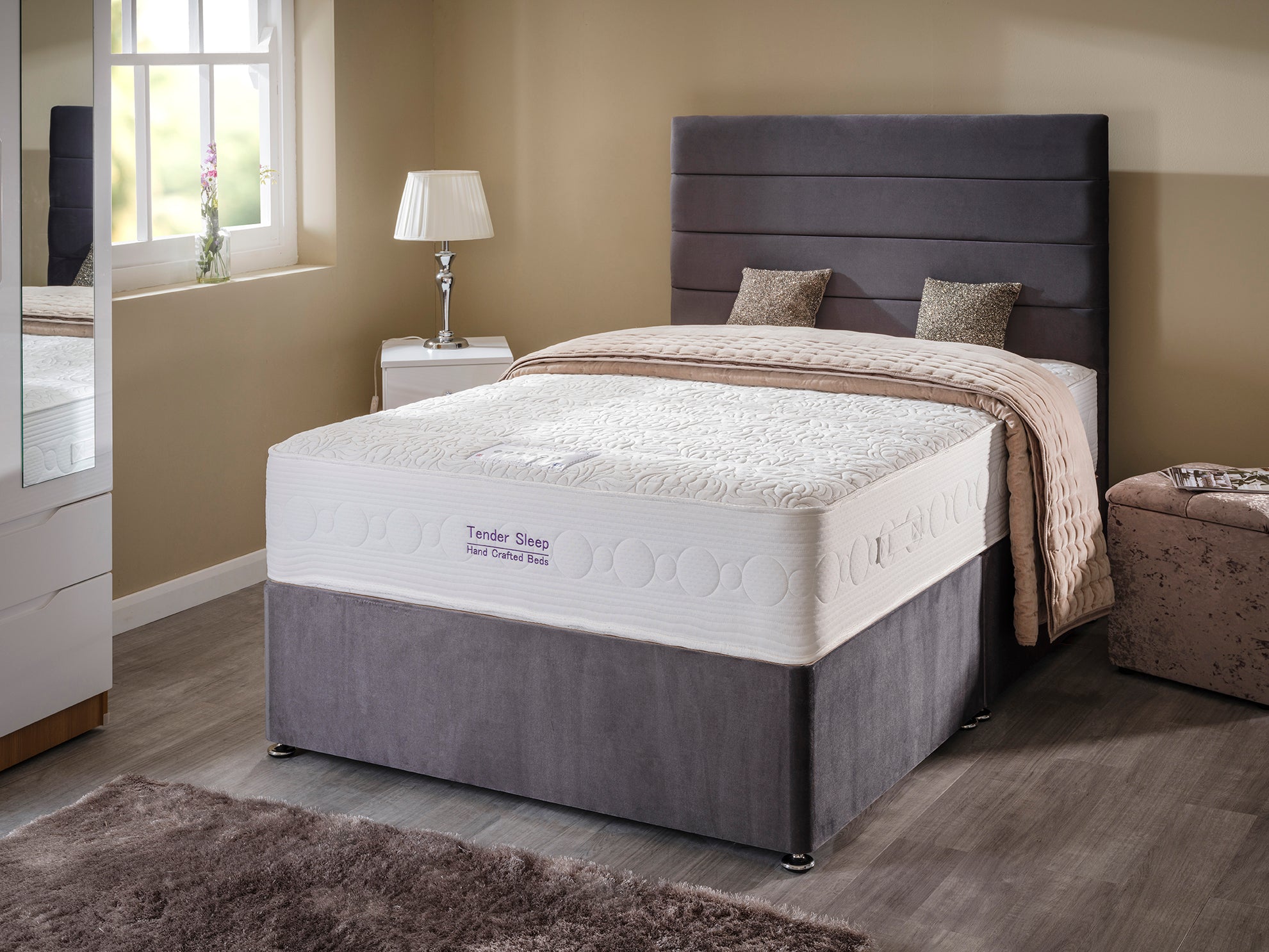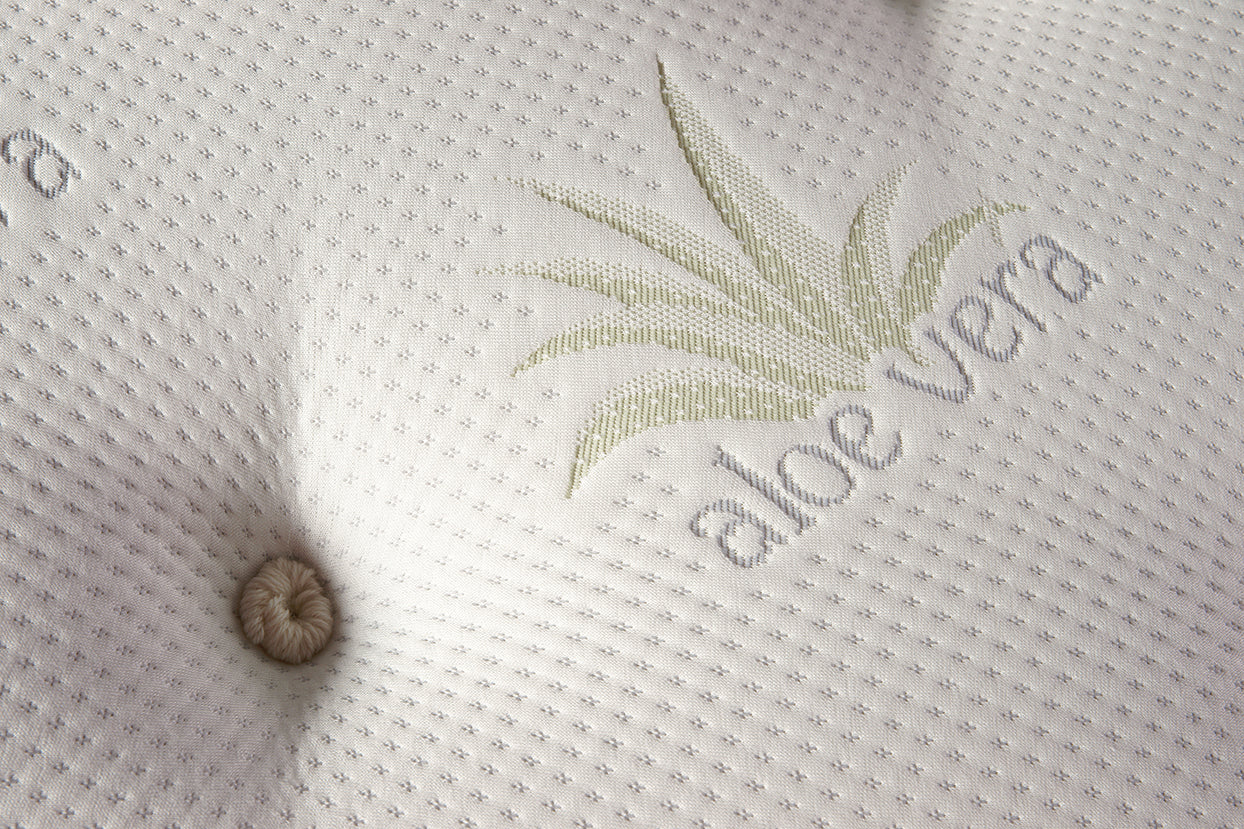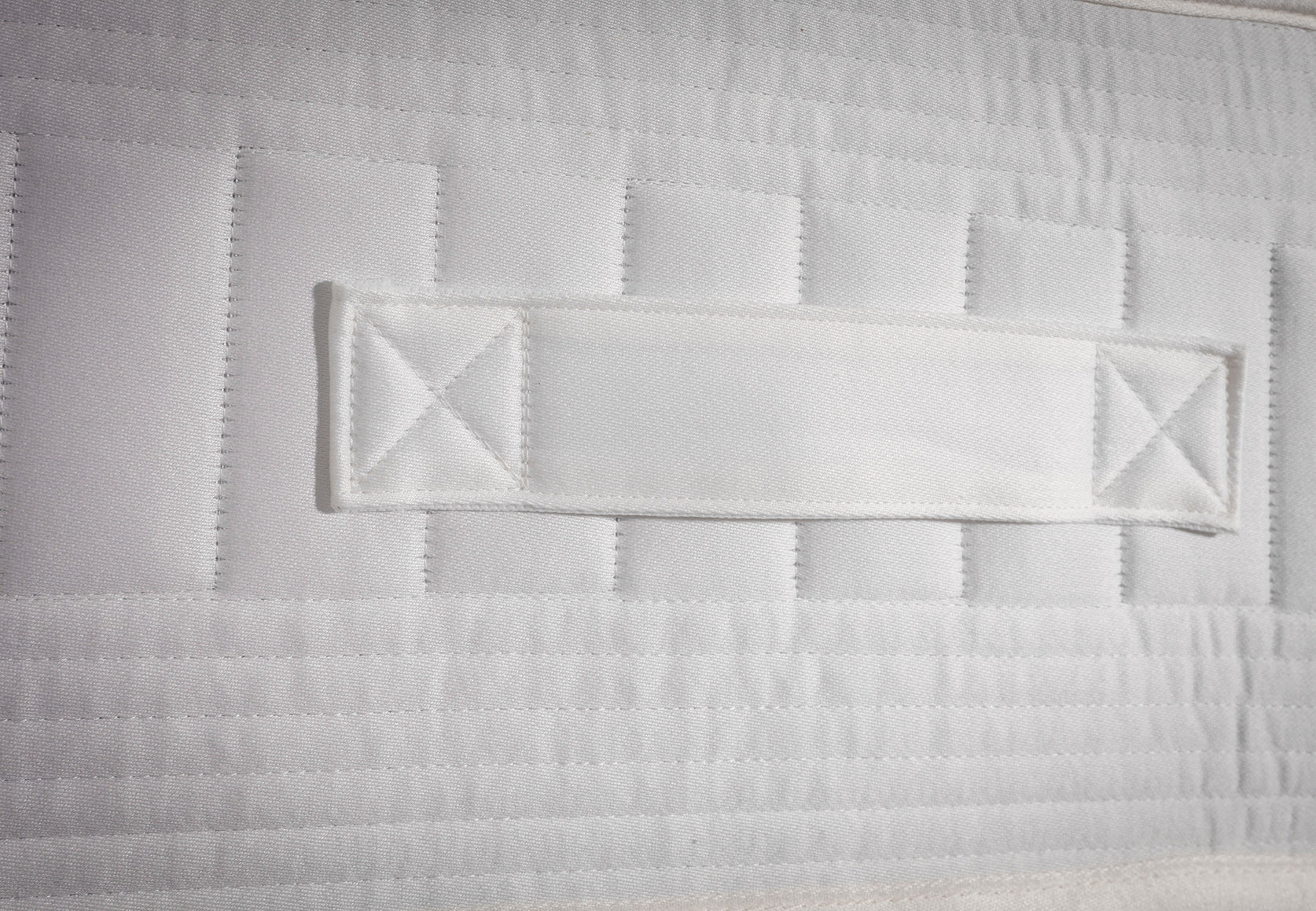Memory foam mattresses offer personalised support and enhanced comfort. Proper maintenance is crucial to ensure your mattress continues to provide optimal comfort and support for years to come. In this guide, we'll explore essential tips and techniques to help you maintain your memory foam mattress, extending its lifespan and preserving its quality. By following these recommendations, you'll be able to enjoy the full benefits of your memory foam mattress for many years.
Key Memory Foam Mattress Maintenance Tips
- Rotate mattress every 3-6 months
- Use a mattress protector
- Hoover regularly
- Spot clean spills immediately
- Ensure proper ventilation
- Avoid excessive moisture
- Use appropriate foundation support
Memory foam mattresses are made from polyurethane with additional chemicals to increase viscosity and elasticity. This unique composition allows the mattress to mould to your body, providing exceptional comfort and support. However, it also means that memory foam mattresses require special care to maintain their quality and longevity. The viscoelastic nature of memory foam means it can be sensitive to temperature changes and pressure distribution, which is why proper maintenance is crucial for preserving its supportive properties.
- Memory foam is heat-responsive, softening with body heat and conforming to your shape for personalised support
- It offers excellent pressure relief and spinal alignment, helping to alleviate common sleep-related aches and pains
- The material can retain heat, which may be a concern for some sleepers, especially in warmer climates
- Memory foam is generally resistant to dust mites and allergens, making it an excellent choice for allergy sufferers
- The density of memory foam can vary, affecting its durability and support characteristics
Understanding these characteristics will help you appreciate why certain maintenance practices are crucial for preserving your mattress's quality and comfort. By following proper care instructions, you can ensure that your memory foam mattress continues to provide the support and comfort you need for a restful night's sleep. Regular maintenance not only extends the life of your mattress but also helps maintain its original comfort and support levels, ensuring you continue to enjoy its benefits for years to come.
Essential Daily Care Practices
Daily care is the foundation of effective memory foam mattress maintenance. By incorporating these simple practices into your routine, you can significantly extend the life of your mattress and ensure a consistently comfortable sleep environment. These practices not only maintain the mattress's physical integrity but also contribute to a more hygienic and comfortable sleep experience.
- Make your bed daily to maintain the mattress shape and prevent dust accumulation
- Use breathable bedding materials to promote air circulation and prevent moisture buildup
- Allow the mattress to air out for 20 minutes each morning to release trapped moisture and odours
- Avoid eating or drinking in bed to prevent spills and stains that can damage the memory foam
- Use a mattress cover to protect against dust, allergens, and accidental spills
- Rotate your sleeping position regularly to distribute wear evenly across the mattress surface
Implementing these daily habits will help keep your mattress in top condition and contribute to a more hygienic sleep environment. Remember, consistency is key when it comes to mattress care. By making these practices a part of your daily routine, you'll be taking important steps to protect your investment and ensure long-lasting comfort. Additionally, these habits can help prevent the buildup of allergens and dust mites, contributing to a healthier sleep environment overall.
Protecting Your Memory Foam Mattress
Protecting your memory foam mattress from spills, stains, and general wear is crucial for maintaining its quality and extending its lifespan. We recommend using high-quality mattress protectors designed specifically for memory foam mattresses. These protectors act as a barrier against moisture, allergens, and dust mites, helping to keep your mattress clean and hygienic. Investing in proper protection is an essential step in preserving the comfort and longevity of your memory foam mattress.
- Use a waterproof mattress protector to guard against spills and accidents, preventing liquid from penetrating the foam
- Choose a breathable protector to maintain the mattress's temperature-regulating properties and prevent heat buildup
- Wash your mattress protector regularly, at least every 1-2 months, to maintain hygiene and remove accumulated allergens
- Consider using additional protective layers like fitted sheets or mattress pads for extra comfort and protection
- Opt for hypoallergenic protectors if you have allergies or sensitivities to ensure a healthier sleep environment
- Ensure the protector fits snugly on your mattress to prevent shifting and bunching during use
By investing in proper protection, you can safeguard your mattress against common issues that could compromise its comfort and durability. A good mattress protector not only extends the life of your mattress but also helps maintain a healthier sleep environment by reducing allergens and dust mites. Remember to choose a protector that fits your mattress size perfectly to ensure complete coverage and protection. Regular maintenance of your mattress protector, including washing and replacing when necessary, will contribute significantly to the overall care of your memory foam mattress.
Regular Cleaning and Maintenance
Regular cleaning is essential for maintaining a hygienic sleep environment and preserving the quality of your memory foam mattress. By incorporating these cleaning techniques into your routine, you can ensure a healthier sleep environment and prolong the life of your mattress. Proper cleaning not only maintains the appearance of your mattress but also helps preserve its structural integrity and comfort properties.
- Hoover the mattress surface weekly using a soft brush attachment to remove dust, dead skin cells, and other particles
- Spot clean spills and stains immediately with a mild detergent solution, being careful not to oversaturate the foam
- Use natural cleaning solutions like bicarbonate of soda to neutralise odours and absorb moisture; sprinkle it on the mattress, let it sit for several hours, then hoover thoroughly
- Avoid using excessive moisture during cleaning to prevent damage to the foam structure
- For deeper cleaning, consider using a specialised foam mattress cleaner following the manufacturer's instructions
- Allow the mattress to air dry completely after any cleaning before making the bed or using a mattress protector
Proper cleaning techniques will help keep your mattress fresh and free from allergens, ensuring a healthier sleep environment. Remember to always follow the manufacturer's care instructions and avoid using harsh chemicals that could damage the memory foam. By maintaining a clean mattress, you're not only ensuring a more comfortable sleep but also protecting your investment for years to come. Regular cleaning also helps prevent the buildup of dust mites and other allergens, contributing to a more hygienic sleep environment overall.

Rotating Your Memory Foam Mattress
Rotating your memory foam mattress is a crucial maintenance practice that helps prevent uneven wear and extends the mattress's lifespan. We recommend rotating your mattress every 3-6 months. This simple practice ensures that the mattress wears evenly over time, maintaining its shape and support properties. Regular rotation is particularly important for memory foam mattresses, as they can develop permanent indentations if pressure is consistently applied to the same areas.
- Rotate your mattress 180 degrees every 3-6 months to distribute wear evenly across the surface
- Use the handles on the sides of the mattress for easier rotation, if available
- Consider marking one end of the mattress to track rotation schedule and ensure consistent rotation
- Avoid flipping memory foam mattresses unless specifically designed for it, as most have a designated top and bottom layer
- Take the opportunity to hoover and inspect your mattress for any signs of wear or damage during rotation
- If you sleep alone or there's a significant weight difference between partners, rotate more frequently to prevent uneven wear
Regular rotation ensures even weight distribution and helps maintain the mattress's shape and support over time. This practice is particularly important for memory foam mattresses, as they can develop permanent indentations if pressure is consistently applied to the same areas. By rotating your mattress, you're helping to distribute wear evenly, which can significantly extend its useful life. Additionally, rotation can help maintain the mattress's comfort and support levels, ensuring a consistently comfortable sleep surface throughout its lifespan.
Providing Proper Support for Your Memory Foam Mattress
The foundation or base you use for your memory foam mattress plays a crucial role in its performance and longevity. Proper support ensures even weight distribution and prevents sagging or premature wear. The right support system not only enhances the comfort of your mattress but also helps maintain its structural integrity over time.
- Use a solid, flat surface or a slatted base with slats no more than 3 inches apart to provide adequate support
- Avoid using divan bases with springs, as they don't provide adequate support for memory foam and can lead to uneven wear
- Consider an adjustable base for added versatility and comfort, especially if you enjoy reading or watching TV in bed
- Ensure the foundation is sturdy and can support the weight of both the mattress and sleepers without sagging
- Check that the foundation is free from defects or damage that could affect the mattress's performance
- If using a platform bed, make sure the surface is smooth and even to prevent any pressure points on the mattress
Ensuring your mattress has the right support will help maintain its shape and provide optimal comfort for years to come. A proper foundation not only enhances the performance of your memory foam mattress but also helps prevent issues like sagging and uneven wear. By investing in the right support system, you're taking an important step in protecting your mattress and ensuring a comfortable sleep experience. Remember that the right foundation can vary depending on the specific type and brand of your memory foam mattress, so always consult the manufacturer's recommendations for the best results.

Managing Temperature and Humidity
Memory foam mattresses can be sensitive to temperature and humidity changes. Proper management of these factors can help maintain the mattress's comfort and prevent issues like mould growth or excessive softening. Understanding how temperature and humidity affect your memory foam mattress is key to ensuring its longevity and performance. By creating an optimal sleep environment, you can enhance both the lifespan of your mattress and the quality of your sleep.
- Maintain ideal room temperature between 16-20°C (60-68°F) for optimal mattress performance and comfort
- Use breathable bedding materials such as cotton or bamboo to promote air circulation and regulate temperature
- Ensure proper ventilation in the bedroom to reduce humidity and prevent moisture buildup in the mattress
- Consider using a dehumidifier in humid climates to protect the mattress from excess moisture
- Use moisture-wicking mattress covers to help manage humidity levels close to the mattress surface
- Avoid placing your mattress directly on the floor, as this can lead to moisture accumulation and temperature fluctuations
By maintaining optimal temperature and humidity levels, you can ensure your memory foam mattress performs at its best and remains comfortable throughout the year. Proper environmental control not only enhances your sleep experience but also helps prevent issues like mould growth and premature deterioration of the foam. Remember, a well-regulated sleep environment is beneficial not just for your mattress, but for your overall sleep quality as well. Consistently managing these factors can significantly extend the life of your memory foam mattress and maintain its supportive properties over time.
Addressing Common Memory Foam Mattress Issues
Even with proper care, memory foam mattresses may occasionally experience issues. Understanding how to address these problems can help you maintain your mattress's quality and comfort. Let's explore some common issues and their solutions to ensure you can quickly and effectively deal with any challenges that arise. By being proactive in addressing these issues, you can maintain the performance and longevity of your memory foam mattress.
- Address body impressions by rotating the mattress regularly and using the entire sleep surface to distribute wear evenly
- Combat odours by airing out the mattress frequently and using bicarbonate of soda to absorb odours; sprinkle it on the mattress, let it sit for several hours, then hoover thoroughly
- Manage heat retention with cooling mattress toppers, breathable bedding, or by adjusting room temperature and ventilation
- Handle spills and stains promptly by blotting with a clean, dry cloth and using appropriate cleaning techniques specific to memory foam
- If the mattress feels too firm, consider using a mattress topper to add an extra layer of softness
- For sagging issues, check the foundation support and consider using a mattress helper or support board under the sagging area
Knowing how to tackle these common issues will help you keep your mattress in top condition and ensure a comfortable sleep experience. Remember, prevention is often the best cure, so maintaining regular care practices can help avoid many of these problems. If you encounter persistent issues, don't hesitate to reach out to the manufacturer or a professional for advice. Addressing problems promptly can prevent them from worsening and help maintain the overall quality and comfort of your memory foam mattress.
When to Consider Replacing Your Memory Foam Mattress
Whilst proper maintenance can significantly extend the life of your memory foam mattress, there will come a time when replacement is necessary. Understanding when to replace your mattress is crucial for maintaining optimal sleep quality and support. Let's explore some key indicators that it might be time to consider a new mattress. Recognising these signs can help you make an informed decision about when to invest in a new sleep surface.
- Visible sagging or permanent indentations that don't recover, indicating a breakdown of the foam structure
- Persistent discomfort or pain upon waking, suggesting the mattress is no longer providing adequate support
- Noticeable changes in sleep quality or worsening allergies, which could be due to accumulation of allergens in the mattress
- The mattress is over 8-10 years old, depending on usage and care, as even well-maintained mattresses have a limited lifespan
- Squeaking or creaking noises when you move, which could indicate issues with the internal structure of the mattress
- Visible signs of wear and tear such as rips, tears, or stains that can't be removed with cleaning
Recognising when it's time for a new mattress ensures you continue to enjoy the benefits of a supportive and comfortable sleep surface. Remember, a good mattress is an investment in your health and well-being. If you're experiencing any of these signs, it might be time to visit Mattress Land's memory foam collection to explore your options for a new, comfortable sleep solution. Investing in a new mattress when needed can significantly improve your sleep quality and overall health, making it a worthwhile consideration when you notice these signs of wear.
FAQs About Memory Foam Mattress Maintenance
To address common concerns and provide additional clarity, here are some frequently asked questions about maintaining memory foam mattresses. These answers will help you better understand how to care for your memory foam mattress and address common maintenance concerns. By familiarising yourself with these FAQs, you'll be better equipped to maintain your mattress effectively and prolong its lifespan.
1. How often should I clean my memory foam mattress?
It's recommended to clean your memory foam mattress every 3-6 months. However, if you have allergies or pets, you might want to clean it more frequently. Regular hoovering and spot cleaning can be done on a weekly or bi-weekly basis to maintain hygiene between deep cleanings. This routine helps prevent the buildup of dust, allergens, and other particles that can affect the mattress's performance and your sleep quality.
2. Can I use a steam cleaner on my memory foam mattress?
No, it's not recommended to use a steam cleaner on memory foam mattresses. The excess moisture and heat can damage the foam structure, potentially leading to mould growth or deterioration of the foam's supportive properties. Stick to dry cleaning methods like hoovering and spot cleaning with mild detergents. If deep cleaning is necessary, consider professional cleaning services that specialise in memory foam mattresses.
3. Is it necessary to use a mattress protector with a memory foam mattress?
Yes, using a mattress protector is highly recommended. It helps protect your mattress from spills, stains, and allergens, extending its lifespan and maintaining hygiene. Choose a breathable, waterproof protector designed for memory foam mattresses. A good mattress protector acts as a barrier against dust mites, bed bugs, and other potential contaminants, helping to maintain a clean and healthy sleep environment.
4. How can I remove stubborn stains from my memory foam mattress?
For stubborn stains, create a mixture of mild detergent and water. Gently blot the stain with a clean cloth dipped in the solution. Avoid saturating the mattress. After cleaning, use a clean, damp cloth to remove any soap residue, and allow the area to dry completely. For tougher stains, you can use a mixture of equal parts water and white vinegar, applying it gently to the stained area. Always test any cleaning solution on a small, inconspicuous area first to ensure it doesn't damage the foam.
5. Can I flip my memory foam mattress?
Most memory foam mattresses are designed to be used on one side only and should not be flipped. However, you should rotate your mattress 180 degrees every 3-6 months to ensure even wear. Always check the manufacturer's instructions for specific guidance on your mattress model. Some newer memory foam mattresses may be designed for flipping, but this is not common. Regular rotation helps distribute wear evenly and can significantly extend the life of your mattress.
Conclusion: Ensuring Long-lasting Comfort with Proper Maintenance
Maintaining your memory foam mattress is essential for ensuring long-lasting comfort and support. By following the guidelines outlined in this article, you can significantly extend the life of your mattress and enjoy a consistently comfortable sleep experience. Remember, proper care not only preserves your investment but also contributes to better sleep quality and overall health. Regular maintenance practices help maintain the unique properties of memory foam, ensuring it continues to provide the personalised support and comfort you expect.
Regular rotation, proper cleaning, and using the right protective measures can make a significant difference in the longevity and performance of your mattress. By implementing these maintenance practices, you'll be well on your way to enjoying years of restful sleep on your memory foam mattress. Consistent care not only extends the life of your mattress but also helps maintain its original comfort and support levels, ensuring you continue to enjoy its benefits night after night.
If you have any questions about mattress maintenance or are considering upgrading your sleep surface, don't hesitate to reach out to our expert team or visit our comfortable sleep surface collection. We're here to ensure you have all the information and products you need for the best possible sleep experience. With proper care and attention, your memory foam mattress can remain a source of comfort and support for many years to come. Sweet dreams and happy sleeping!
Regular Care
Rotate mattress and hoover regularly
Protection
Use mattress protector and proper foundation
Environment
Ensure ventilation and avoid moisture










